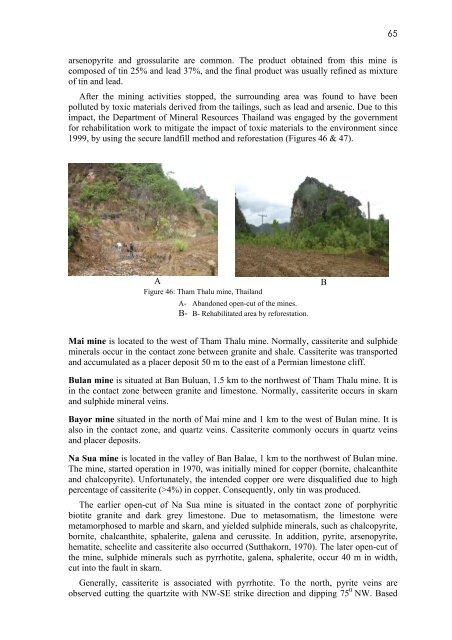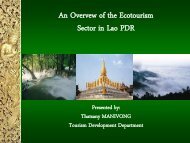GEOLOGY OF THE PENGKALAN HULU-BETONG TRANSECT ...
GEOLOGY OF THE PENGKALAN HULU-BETONG TRANSECT ...
GEOLOGY OF THE PENGKALAN HULU-BETONG TRANSECT ...
Create successful ePaper yourself
Turn your PDF publications into a flip-book with our unique Google optimized e-Paper software.
arsenopyrite and grossularite are common. The product obtained from this mine is<br />
composed of tin 25% and lead 37%, and the final product was usually refined as mixture<br />
of tin and lead.<br />
After the mining activities stopped, the surrounding area was found to have been<br />
polluted by toxic materials derived from the tailings, such as lead and arsenic. Due to this<br />
impact, the Department of Mineral Resources Thailand was engaged by the government<br />
for rehabilitation work to mitigate the impact of toxic materials to the environment since<br />
1999, by using the secure landfill method and reforestation (Figures 46 & 47).<br />
A<br />
Figure 46: Tham Thalu mine, Thailand<br />
A- Abandoned open-cut of the mines.<br />
B- B- Rehabilitated area by reforestation.<br />
Mai mine is located to the west of Tham Thalu mine. Normally, cassiterite and sulphide<br />
minerals occur in the contact zone between granite and shale. Cassiterite was transported<br />
and accumulated as a placer deposit 50 m to the east of a Permian limestone cliff.<br />
Bulan mine is situated at Ban Buluan, 1.5 km to the northwest of Tham Thalu mine. It is<br />
in the contact zone between granite and limestone. Normally, cassiterite occurs in skarn<br />
and sulphide mineral veins.<br />
Bayor mine situated in the north of Mai mine and 1 km to the west of Bulan mine. It is<br />
also in the contact zone, and quartz veins. Cassiterite commonly occurs in quartz veins<br />
and placer deposits.<br />
Na Sua mine is located in the valley of Ban Balae, 1 km to the northwest of Bulan mine.<br />
The mine, started operation in 1970, was initially mined for copper (bornite, chalcanthite<br />
and chalcopyrite). Unfortunately, the intended copper ore were disqualified due to high<br />
percentage of cassiterite (>4%) in copper. Consequently, only tin was produced.<br />
The earlier open-cut of Na Sua mine is situated in the contact zone of porphyritic<br />
biotite granite and dark grey limestone. Due to metasomatism, the limestone were<br />
metamorphosed to marble and skarn, and yielded sulphide minerals, such as chalcopyrite,<br />
bornite, chalcanthite, sphalerite, galena and cerussite. In addition, pyrite, arsenopyrite,<br />
hematite, scheelite and cassiterite also occurred (Sutthakorn, 1970). The later open-cut of<br />
the mine, sulphide minerals such as pyrrhotite, galena, sphalerite, occur 40 m in width,<br />
cut into the fault in skarn.<br />
Generally, cassiterite is associated with pyrrhotite. To the north, pyrite veins are<br />
observed cutting the quartzite with NW-SE strike direction and dipping 75 0 NW. Based<br />
B<br />
65



